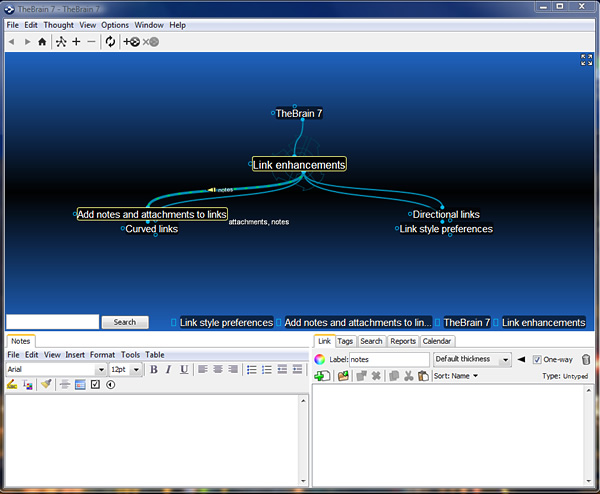TheBrain Technologies, developer of the popular Personal Brain mind mapping and personal information management tool, recently released version 7 of the program, which has now been rechristened as TheBrain 7. It features enhanced ways to connect and link information within the program’s highly visual user interface.
According to the developer, TheBrain 7 contains over 50 new features and enhancements, including:
Animated, curved links, which make it easier to understand the relationships between pieces of information in your mind maps, plus expanded preferences for formatting topic links. Line widths of up to 15 pixels wide are now supported in version 7. I spent some time working with TheBrain 7, and found that the curved versus straight links of its predecessor don’t make that big of a difference.
Expanded linking and relationship mapping: Links in TheBrain 7 can now have arrows embedded within them to show directionality. Links can also contain notes and attachments, in addition to labels, colors and thickness attributes. This enables TheBrain 7 to be used for concept modeling and enables you to better understand how and why items are connected to each other. Advanced link properties, including direction, one-way links, notes, and attachments, are not available via the Web client.
Maximize plex button: TheBrain 7 workspace – which its developer calls the “plex” – now contains a 4-headed arrow in the upper right corner of the workspace. Clicking on it causes the program’s toolbar and its properties dialog boxes, which line the top and bottom of the screen, respectively, to disappear from view. This enables you to see more of your brain, which should be useful when working with large files or when using TheBrain 7 on a smaller screen.
Calendar improvements: TheBrain 7 can now display multiple-date events, with a black horizontal line spanning multiple days.
Improved integration between the cloud and the desktop program: TheBrain 7 offers tighter integration between the desktop and cloud-based versions of the program. When you first open TheBrain 7, it automatically connects with TheBrain’s online service, and displays all of your local and online brains in a single list, with a screen shot of each. Beneath the file name, TheBrain 7 displays whether a brain is located locally, online or both.
Improved performance and new database back end: Personal Brain never put any limits on how many thoughts a mind map could contain. Users have created maps with as many as 10,000 topics. For version 7, the software’s database back end has been rewritten for improved performance when users are working with large, complex maps.
Pricing for TheBrain 7
TheBrain 7 is offered in two editions: Free and Pro. TheBrain Free is offered at no charge and does not expire. Anyone can link ideas and web pages on their desktop and in the cloud. It doesn’t allow you to add file attachments to your brain, and only provides basic reports and no Outlook integration or printing capabilities. The Pro version offers greater options for formatting your maps, advanced search, secure cloud backup and more. TheBrain Pro is available now for US219; a Pro Combo option enables you to access the program’s cloud services, upgrades and a perpetual license at US$299 the first year, with $159 per year renewals.
Conclusion
If you are a previous user of Personal Brain, I’m not sure if I can categorically recommend that you upgrade to TheBrain 7. If you work with large files with thousands of links or need to create concept maps or other visual diagrams with more “intelligent” links, you may want to consider it. Otherwise, I’m not sure it offers a big enough leap in functionality and cosmetics to make it worth the investment. As I indicated earlier, I’m on the fence regarding curved versus straight topic links. I just don’t think it brings that much new to the table.


Leave a Reply